Legal Structures and Company Formation
54 Pages15453 Words27 Views
Added on 2022-04-04
About This Document
This study material focuses on types of Business Organization - incorporated and unincorporated business and explains how different types of business organizations are legally formed. Access the advantages and disadvantages of the formation of different types of business organizations. Discuss Effectiveness of Legal Solution and Legal Advice and Support.
Legal Structures and Company Formation
Added on 2022-04-04
ShareRelated Documents
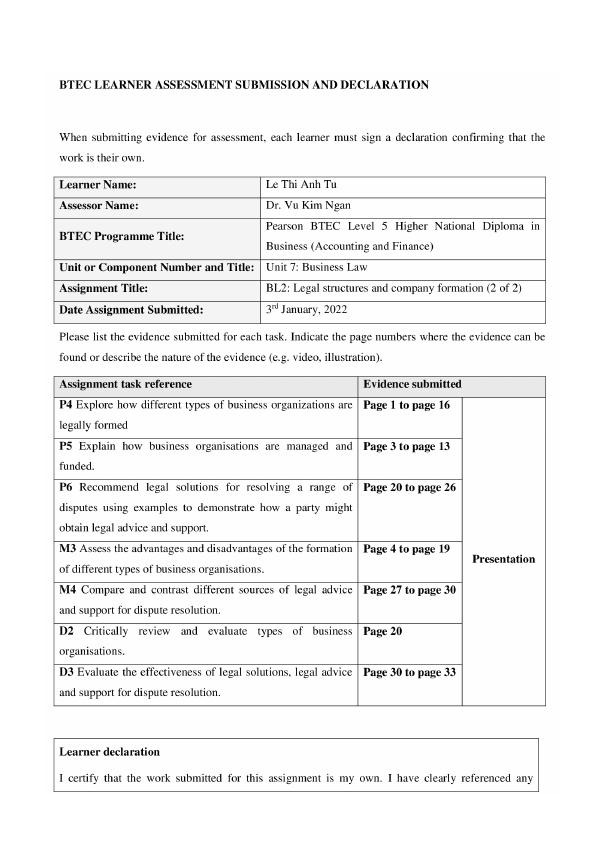
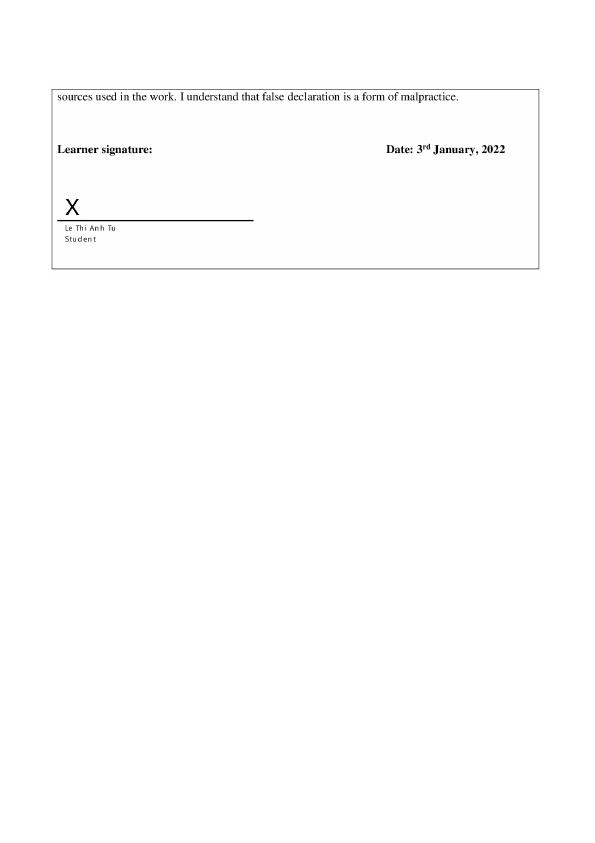
1
“Section A: Types of business organizations”
I- Introduction of incorporated and unincorporated business
“In this part of the presentation, I will focus analysis on two types of businesses organization: incorporated
and unincorporated business. In detail, for the type of unincorporated business, there will be 2 main types:
sole trader and partnership, in which partnership has 3 types of partnerships: general partnership, limited
partnership, liability limited partnership. And the second type is incorporated business, there will be 2 main
types: private and public company. And the following is detailed information about the definition,
characteristics, formation, management, source of finance, advantages and disadvantages of the above types
of businesses.”
II- Unincorporated business
1. Sole trader
1.1. Definition
“A sole trader, also known as a sole proprietorship, is a simple business structure in which one individual run
and owns the entire business. A sole trader is entitled to keep all profits after taxes have been deducted but
is also liable for all losses the business incurs.”(Enotes, 2021)
1.2. Characteristics
“Sole trader has the following 7 basic characteristics. The first characteristic is Sole ownership. In detail, the
ownership and the responsibility of the entire firm falls under one person - the owner of the firm. On the
closure of business, the owner is liable for all the profits and losses legally. The second characteristic is
Unlimited liability. This means the liability of the owner is unlimited. In a situation like bankruptcy or any
loss in the business, the loss can be recovered by selling both the business and the private asset (i.e. house,
land, etc.) of the proprietor. The third characteristic is Limited work area. The progress and work area of a
sole proprietor firm is limited. This is because the capital acquiring capability, organizational skills and the
available resources of an individual are limited. The fourth characteristic is Sole right on capital. The
owner of the proprietorship firm enjoys full rights on the capital gains and is the sole owner of the same as
the capital invested in the firm has to be organized by the sole proprietor. The fifth characteristic is No legal
formalities. A sole trader does not need to complete formalities like registration. The sixth characteristic is
Free to select business. A proprietor is free to select any business of their choice as per their will. They can
also change the line of business. The last characteristic is Willful commencement and closure. It is up to
the disposal of the owner to either start or shut the firm. All the decisions are taken by the owner of the firm
and as it is a non-legal entity, so there are no legal formalities involved.”(Enotes, 2021)
1.3. Formation
“Section A: Types of business organizations”
I- Introduction of incorporated and unincorporated business
“In this part of the presentation, I will focus analysis on two types of businesses organization: incorporated
and unincorporated business. In detail, for the type of unincorporated business, there will be 2 main types:
sole trader and partnership, in which partnership has 3 types of partnerships: general partnership, limited
partnership, liability limited partnership. And the second type is incorporated business, there will be 2 main
types: private and public company. And the following is detailed information about the definition,
characteristics, formation, management, source of finance, advantages and disadvantages of the above types
of businesses.”
II- Unincorporated business
1. Sole trader
1.1. Definition
“A sole trader, also known as a sole proprietorship, is a simple business structure in which one individual run
and owns the entire business. A sole trader is entitled to keep all profits after taxes have been deducted but
is also liable for all losses the business incurs.”(Enotes, 2021)
1.2. Characteristics
“Sole trader has the following 7 basic characteristics. The first characteristic is Sole ownership. In detail, the
ownership and the responsibility of the entire firm falls under one person - the owner of the firm. On the
closure of business, the owner is liable for all the profits and losses legally. The second characteristic is
Unlimited liability. This means the liability of the owner is unlimited. In a situation like bankruptcy or any
loss in the business, the loss can be recovered by selling both the business and the private asset (i.e. house,
land, etc.) of the proprietor. The third characteristic is Limited work area. The progress and work area of a
sole proprietor firm is limited. This is because the capital acquiring capability, organizational skills and the
available resources of an individual are limited. The fourth characteristic is Sole right on capital. The
owner of the proprietorship firm enjoys full rights on the capital gains and is the sole owner of the same as
the capital invested in the firm has to be organized by the sole proprietor. The fifth characteristic is No legal
formalities. A sole trader does not need to complete formalities like registration. The sixth characteristic is
Free to select business. A proprietor is free to select any business of their choice as per their will. They can
also change the line of business. The last characteristic is Willful commencement and closure. It is up to
the disposal of the owner to either start or shut the firm. All the decisions are taken by the owner of the firm
and as it is a non-legal entity, so there are no legal formalities involved.”(Enotes, 2021)
1.3. Formation
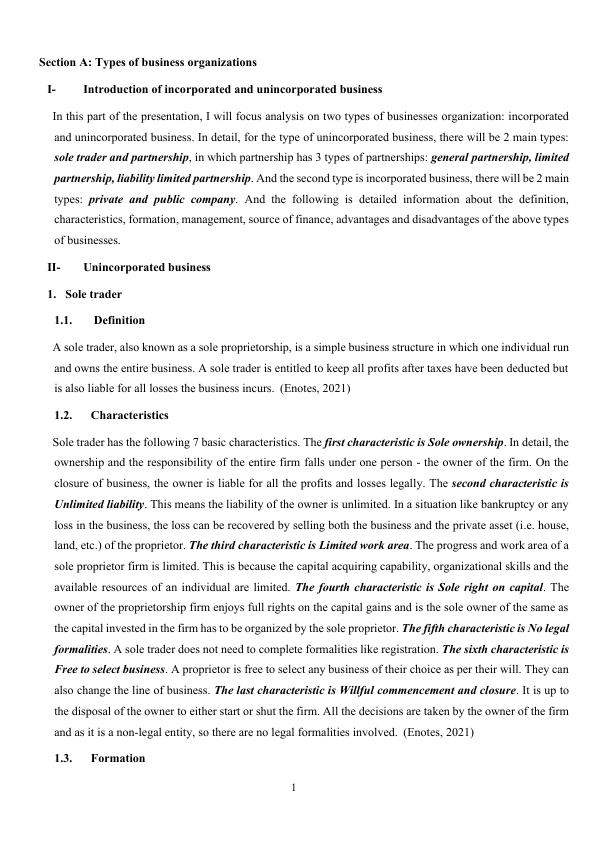
2
a) Set up
“According to GOV.UK (2021), Operating as a sole proprietorship is the simplest and cheapest business
structure that can be established by qualified and behaviorally qualified individuals. And to set up a sole
trader, there are 4 basic steps as follows.”
- Check if the self-employment is right for you: “Business owners should check to see what type of
business should be established in accordance with its capabilities, capital and benefits.”
- Choose a name for the company: “Sole trader do not need to register a business name. But if you
want to expand your company's image and brand, you should register your business name with the
business registration agency so that you can easily transact with other related parties.”
- Check the records to keep: “Business owners must keep records of their business income and
expenses for tax return if self-employed as a sole trader. Besides, business owners should also choose
an accounting method to record the expenses and income of the business.”
- Tax registration: “To be a sole trader, that individual needs to let HMRC (Her Majesty's Revenue
and Customs) know that you pay taxes through a Self Assessment. Sole proprietorship owners will
need to file an annual tax return.”
b) Business name
“A business owner can conduct transactions in his or her name, or a business owner names his or her
business and conducts transactions with related parties using the business name. For the type of sole
trader there is no requirement to register the business name.”(GOV.UK, 2021)
“In case the business owner has registered the business name, when making transactions, paying bills,
sending letters to related parties, it is necessary to have the name of the business owner and the name of
the previously registered business. And when registering a business name, business owners should note
the following things. The unique business name at registration cannot contain the following words:
'limited', 'LTD', 'limited liability partnership', 'LLP', 'public limited liability company ' or 'plc'. The
business name must not resemble previously registered trademarks and the business name must not be
offensive, contain 'sensitive' words or expressions, or suggest a government or government connection
local, unless authorized.”(GOV.UK, 2021)
c) Responsibilities
“Once a sole trader enterprise has been established, the business owner must have the following
responsibilities to the company. The first is that the business owner needs to keep a record of the revenue
and expenses of the business. In addition, business owners must submit an annual Self-Assessment tax
return. And the business owner must pay income tax based on the business owner's profits and Category
2 and Category 4 National Insurance (business owners can use HMRC's calculator to budget this).
a) Set up
“According to GOV.UK (2021), Operating as a sole proprietorship is the simplest and cheapest business
structure that can be established by qualified and behaviorally qualified individuals. And to set up a sole
trader, there are 4 basic steps as follows.”
- Check if the self-employment is right for you: “Business owners should check to see what type of
business should be established in accordance with its capabilities, capital and benefits.”
- Choose a name for the company: “Sole trader do not need to register a business name. But if you
want to expand your company's image and brand, you should register your business name with the
business registration agency so that you can easily transact with other related parties.”
- Check the records to keep: “Business owners must keep records of their business income and
expenses for tax return if self-employed as a sole trader. Besides, business owners should also choose
an accounting method to record the expenses and income of the business.”
- Tax registration: “To be a sole trader, that individual needs to let HMRC (Her Majesty's Revenue
and Customs) know that you pay taxes through a Self Assessment. Sole proprietorship owners will
need to file an annual tax return.”
b) Business name
“A business owner can conduct transactions in his or her name, or a business owner names his or her
business and conducts transactions with related parties using the business name. For the type of sole
trader there is no requirement to register the business name.”(GOV.UK, 2021)
“In case the business owner has registered the business name, when making transactions, paying bills,
sending letters to related parties, it is necessary to have the name of the business owner and the name of
the previously registered business. And when registering a business name, business owners should note
the following things. The unique business name at registration cannot contain the following words:
'limited', 'LTD', 'limited liability partnership', 'LLP', 'public limited liability company ' or 'plc'. The
business name must not resemble previously registered trademarks and the business name must not be
offensive, contain 'sensitive' words or expressions, or suggest a government or government connection
local, unless authorized.”(GOV.UK, 2021)
c) Responsibilities
“Once a sole trader enterprise has been established, the business owner must have the following
responsibilities to the company. The first is that the business owner needs to keep a record of the revenue
and expenses of the business. In addition, business owners must submit an annual Self-Assessment tax
return. And the business owner must pay income tax based on the business owner's profits and Category
2 and Category 4 National Insurance (business owners can use HMRC's calculator to budget this).

3
Besides, business owners will need to apply for a National Insurance number if moving to the UK to set
up a business.” (GOV.UK, 2021)
“For VAT, a business owner must register for VAT if his/her annual turnover is over £85,000. Business
owners can also register voluntarily if it feels right for their business. In case, the business owner
establishes a a construction industry sole proprietorship, he/she must register with HMRC for the
Construction Industry Program (CIS) as a subcontractor or contractor.”(GOV.UK, 2021)
1.4. Management
“For a sole trader, the business owner has full authority to manage and control the business activities of the
enterprise. And the management task of the business owner starts from the time the business comes into
operation until the company closes. In the following, I will clarify the POCCC management model in sole
trader.”
“Planning: The business owner is the person who manages and makes business development plans that are
most suitable to the current conditions of the business, such as plans to recruit employees, purchase
production equipment, lease factories.”
“Organizing: The business owner is not required to consult any shareholders before making a decision.
Business owners must organize necessary activities such as organizing job interviews, hiring employees,
training and managing. Besides, business owners also need to determine the work that needs to be done to
run the business, and divide the work appropriately for each group of employees. In addition, business
owners can entrust employees with certain, clear tasks and powers”
“Coordinating: The business owner is the one who coordinates all employees work by choosing methods to
support work and assigning employees to work in the right roles. And business owners need to guide
employees to work in a good way because many positions have complex work nature. And the business
owner is also the one who analyzes, guides and answers the questions of employees when they have
difficulties.”
“Commanding: The business owner directs and guides the employees to work according to his/her plan to
ensure that the effective work process achieves the best results. From there, it can help the company develop
and avoid business risks.”
“Controlling: The business owner is the person who supervises the employees to ensure that the employees
come to work fully, strictly comply with the regulations of the business and that the employees work
correctly with the assigned tasks. From there, business owners can achieve business goals, avoid employee
fraud, and help the company develop better.”
1.5. Sources of Finance
Many small businesses choose to operate as a sole proprietor because it is the fastest and easiest way to start
Besides, business owners will need to apply for a National Insurance number if moving to the UK to set
up a business.” (GOV.UK, 2021)
“For VAT, a business owner must register for VAT if his/her annual turnover is over £85,000. Business
owners can also register voluntarily if it feels right for their business. In case, the business owner
establishes a a construction industry sole proprietorship, he/she must register with HMRC for the
Construction Industry Program (CIS) as a subcontractor or contractor.”(GOV.UK, 2021)
1.4. Management
“For a sole trader, the business owner has full authority to manage and control the business activities of the
enterprise. And the management task of the business owner starts from the time the business comes into
operation until the company closes. In the following, I will clarify the POCCC management model in sole
trader.”
“Planning: The business owner is the person who manages and makes business development plans that are
most suitable to the current conditions of the business, such as plans to recruit employees, purchase
production equipment, lease factories.”
“Organizing: The business owner is not required to consult any shareholders before making a decision.
Business owners must organize necessary activities such as organizing job interviews, hiring employees,
training and managing. Besides, business owners also need to determine the work that needs to be done to
run the business, and divide the work appropriately for each group of employees. In addition, business
owners can entrust employees with certain, clear tasks and powers”
“Coordinating: The business owner is the one who coordinates all employees work by choosing methods to
support work and assigning employees to work in the right roles. And business owners need to guide
employees to work in a good way because many positions have complex work nature. And the business
owner is also the one who analyzes, guides and answers the questions of employees when they have
difficulties.”
“Commanding: The business owner directs and guides the employees to work according to his/her plan to
ensure that the effective work process achieves the best results. From there, it can help the company develop
and avoid business risks.”
“Controlling: The business owner is the person who supervises the employees to ensure that the employees
come to work fully, strictly comply with the regulations of the business and that the employees work
correctly with the assigned tasks. From there, business owners can achieve business goals, avoid employee
fraud, and help the company develop better.”
1.5. Sources of Finance
Many small businesses choose to operate as a sole proprietor because it is the fastest and easiest way to start
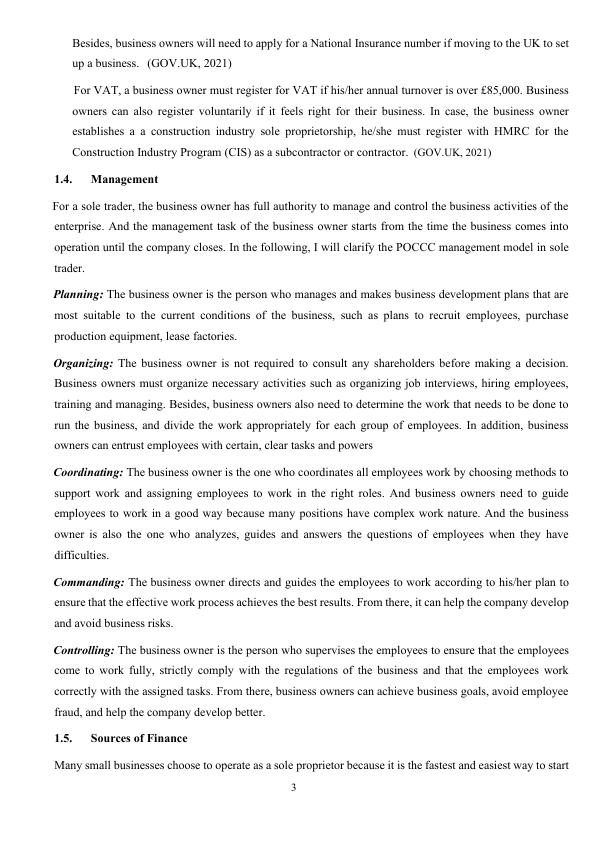
4
a business. However, finding the money to buy equipment and manage day-to-day operations in a sole trader
is not quick and easy. And there are two sources of finance: equity capital and debt capital. Here are some
financial resources that a sole proprietorship business can use to run and grow the company stronger:
“For equity capital, there are three main sources of cash flow from the business owner, profit from the
business's operations, and cash from the sale of inventory and assets. Cash flow of business owners is the
source of capital for businesses that can maintain operations in the early days of establishment and have not
yet earned business profits. Besides, the owner's cash flow is also a source of money to help businesses
secure bank loans. In general, this is a cheap and beneficial source of finance for business owners because
they can use it however, they like to manage the company. And businesses exist to make profits and business
owners can withdraw profits so that they can be reinvested to expand their business or undertake other
development projects. Business often runs out of stock, and businesses will tend to sell their inventory at a
discounted price - a great way to raise the money a business owner needs. In case the business has excess
machinery, the business owner can sell it and use the money to serve other business activities.”(Thompson,
2022)
“There are three sources of debt capital in sole trader as follows. The first is a loan from a bank. A bank is
a place where business owners can borrow money and borrow large amounts to serve the company's business
activities. However, the bank will use the business owner's personal assets as a basis for approving loans,
ensuring that the owner can repay the loan. The second is the source of money that business owners borrow
from family members and friends. This is a source of money borrowed with low interest rates and
preferential repayment terms. In particular, loans are quicker and easier to arrange than bank loans. And
finally, the source of money from credit support. A credit card is essentially a revolving lending vehicle
that allows you to borrow up to a pre-agreed limit, then pay the balance over time. It is a useful way to cover
a temporary cash flow shortfall. Credit cards are compounded, which means that a monthly interest fee is
transferred to the account balance each month and the borrower pays "interest".”(Thompson, 2022)
1.6. Advantages and Disadvantages
“The following are the benefits that business owners get when setting up a sole proprietorship. The first is
that a sole proprietorship is easy to set up, it doesn't have to deal with the formalities and paperwork involved
in setting up a limited liability company or partnership. Business owners can start their business immediately
when they want, without even choosing a business name or setting up a business bank account. The second
is that the business owner will keep all the after-tax profits for his/her business. The third is the low Start-
up Cost as a Sole Trader. The registration process with HMRC is free, so setting up as the sole trader won't
incur any costs. Finally, it is easy to change the business structure. If you want to start small and then
expand, operating as a sole proprietorship allows the business owner to do just that. He/She can easily change
his/her business structure.”(Bishop, 2021)
a business. However, finding the money to buy equipment and manage day-to-day operations in a sole trader
is not quick and easy. And there are two sources of finance: equity capital and debt capital. Here are some
financial resources that a sole proprietorship business can use to run and grow the company stronger:
“For equity capital, there are three main sources of cash flow from the business owner, profit from the
business's operations, and cash from the sale of inventory and assets. Cash flow of business owners is the
source of capital for businesses that can maintain operations in the early days of establishment and have not
yet earned business profits. Besides, the owner's cash flow is also a source of money to help businesses
secure bank loans. In general, this is a cheap and beneficial source of finance for business owners because
they can use it however, they like to manage the company. And businesses exist to make profits and business
owners can withdraw profits so that they can be reinvested to expand their business or undertake other
development projects. Business often runs out of stock, and businesses will tend to sell their inventory at a
discounted price - a great way to raise the money a business owner needs. In case the business has excess
machinery, the business owner can sell it and use the money to serve other business activities.”(Thompson,
2022)
“There are three sources of debt capital in sole trader as follows. The first is a loan from a bank. A bank is
a place where business owners can borrow money and borrow large amounts to serve the company's business
activities. However, the bank will use the business owner's personal assets as a basis for approving loans,
ensuring that the owner can repay the loan. The second is the source of money that business owners borrow
from family members and friends. This is a source of money borrowed with low interest rates and
preferential repayment terms. In particular, loans are quicker and easier to arrange than bank loans. And
finally, the source of money from credit support. A credit card is essentially a revolving lending vehicle
that allows you to borrow up to a pre-agreed limit, then pay the balance over time. It is a useful way to cover
a temporary cash flow shortfall. Credit cards are compounded, which means that a monthly interest fee is
transferred to the account balance each month and the borrower pays "interest".”(Thompson, 2022)
1.6. Advantages and Disadvantages
“The following are the benefits that business owners get when setting up a sole proprietorship. The first is
that a sole proprietorship is easy to set up, it doesn't have to deal with the formalities and paperwork involved
in setting up a limited liability company or partnership. Business owners can start their business immediately
when they want, without even choosing a business name or setting up a business bank account. The second
is that the business owner will keep all the after-tax profits for his/her business. The third is the low Start-
up Cost as a Sole Trader. The registration process with HMRC is free, so setting up as the sole trader won't
incur any costs. Finally, it is easy to change the business structure. If you want to start small and then
expand, operating as a sole proprietorship allows the business owner to do just that. He/She can easily change
his/her business structure.”(Bishop, 2021)
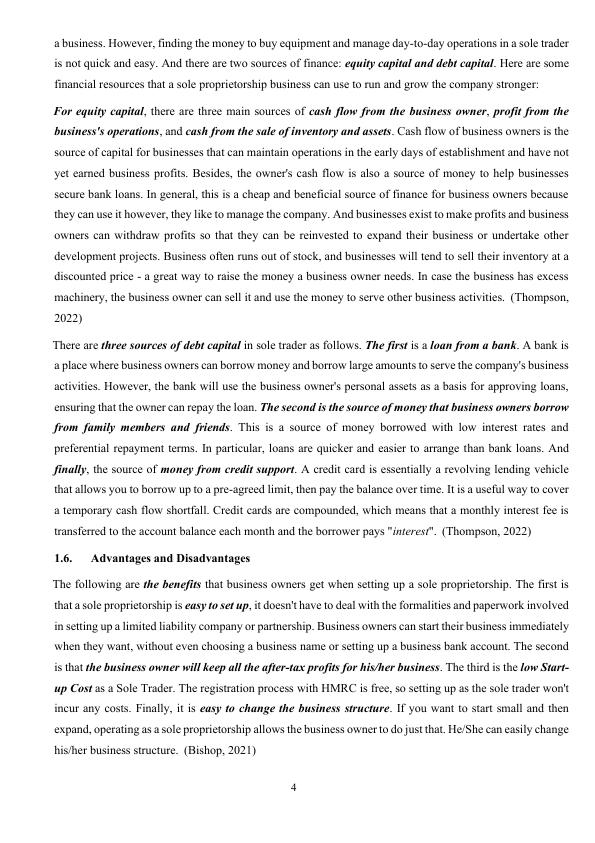
5
“On the other hand, when setting up a sole trader, there are also some disadvantages as follows. The first
disadvantage is that a sole proprietorship is highly risky because the business owner has unlimited liability
to the business. Proprietary ownership gives business owners the freedom to act as they see reasonable —
subject only to licensing authorizations without registration or shareholders — this freedom comes with
responsibility. As sole proprietors, they are personally responsible for paying contractors, debts, paying
necessary taxes and insurance for their employees, and any legal action. In case of debt default, they will
have to be responsible for that debt with all their assets such as houses, cars, bank accounts,... And the
remaining disadvantage is that sole trader will have difficulty in raising capital. Because a sole proprietor's
personal liability presents a risk, and for this reason, banks may be hesitant to lend money or extend credit
under this business structure. As a sole proprietor, it is also more difficult to attract investors because the
company is not officially recognized and is not designated to have shareholders.”(Bishop, 2021)
Assessment: “From the advantages and disadvantages of a sole trader, I judge that this type of business is
suitable for individuals who want to do business alone and do not hesitate to take unlimited liability for the
business with all your assets because a sole trader is very easy to set up, low cost and with this type you will
not be able to do business with other people. And to set up a sole trader, you must have a certain amount of
capital, enough to maintain the business activities of the business because owner's capital is the main source
of capital of a sole trader.”
2. Partnership
2.1. Definition
“The term partnership, is used to mean a business structure wherein two or more individuals, come together
for undertaking a lawful business and have agreed to share the profits and losses arising from it.”(Jargons,
2021)
2.2. Characteristics
According to Jargons (2021), a partnership company has the following characteristics.
- Membership: “At least two people are required to start a partnership while the maximum number of
members is limited to 100 people. And all individuals participating in a partnership must have full legal
capacity because they must sign a contract to become a general partner. Therefore, minors, insolvent
persons and lunatics cannot become members.”
- Liability: “The members of a partnership have unlimited liability, they are responsible for the debts and
obligations of the company. In the event that the business assets of the company are not sufficient to
repay the debt, the personal assets of all members or any of the partners may be collected by the creditor
to settle the outstanding amount.”
- Profit and loss sharing: “The purpose of establishing a partnership is to divide profits according to the
“On the other hand, when setting up a sole trader, there are also some disadvantages as follows. The first
disadvantage is that a sole proprietorship is highly risky because the business owner has unlimited liability
to the business. Proprietary ownership gives business owners the freedom to act as they see reasonable —
subject only to licensing authorizations without registration or shareholders — this freedom comes with
responsibility. As sole proprietors, they are personally responsible for paying contractors, debts, paying
necessary taxes and insurance for their employees, and any legal action. In case of debt default, they will
have to be responsible for that debt with all their assets such as houses, cars, bank accounts,... And the
remaining disadvantage is that sole trader will have difficulty in raising capital. Because a sole proprietor's
personal liability presents a risk, and for this reason, banks may be hesitant to lend money or extend credit
under this business structure. As a sole proprietor, it is also more difficult to attract investors because the
company is not officially recognized and is not designated to have shareholders.”(Bishop, 2021)
Assessment: “From the advantages and disadvantages of a sole trader, I judge that this type of business is
suitable for individuals who want to do business alone and do not hesitate to take unlimited liability for the
business with all your assets because a sole trader is very easy to set up, low cost and with this type you will
not be able to do business with other people. And to set up a sole trader, you must have a certain amount of
capital, enough to maintain the business activities of the business because owner's capital is the main source
of capital of a sole trader.”
2. Partnership
2.1. Definition
“The term partnership, is used to mean a business structure wherein two or more individuals, come together
for undertaking a lawful business and have agreed to share the profits and losses arising from it.”(Jargons,
2021)
2.2. Characteristics
According to Jargons (2021), a partnership company has the following characteristics.
- Membership: “At least two people are required to start a partnership while the maximum number of
members is limited to 100 people. And all individuals participating in a partnership must have full legal
capacity because they must sign a contract to become a general partner. Therefore, minors, insolvent
persons and lunatics cannot become members.”
- Liability: “The members of a partnership have unlimited liability, they are responsible for the debts and
obligations of the company. In the event that the business assets of the company are not sufficient to
repay the debt, the personal assets of all members or any of the partners may be collected by the creditor
to settle the outstanding amount.”
- Profit and loss sharing: “The purpose of establishing a partnership is to divide profits according to the
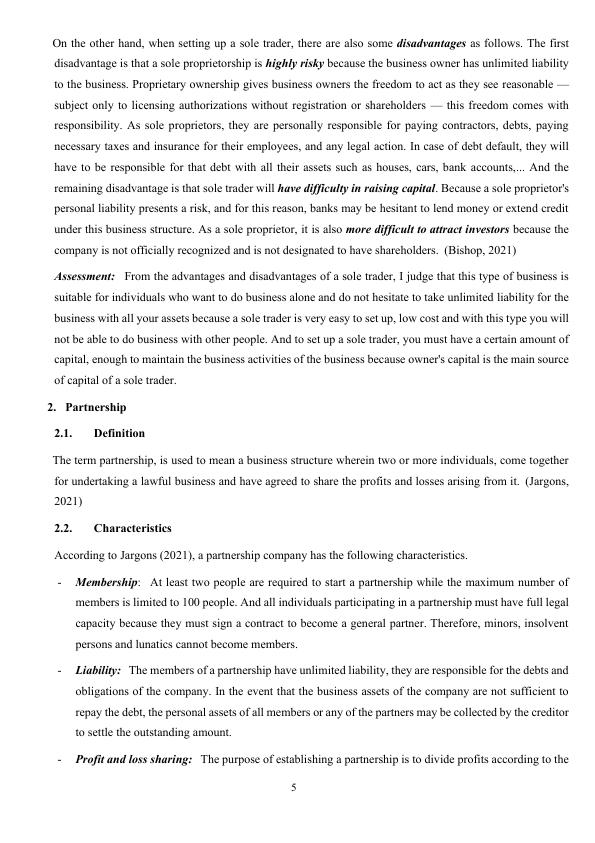
6
ratio previously agreed between the general partners and the limited partners. In case there is no
agreement between the limited partners, the profit or loss of the enterprise is divided equally among all
partners.”
- Mutual agency: “The partnership business is carried out by all the general partners, so the general
partners are all representatives of the business and the actions of the partners are binding on each other
as well as the company.”
- “The registration to become a general partner is not mandatory, but it is recommended as it provides
certain benefits, for example, in case of any conflict between the partners, any of the partners can sue
the other partner.”
- “In case the company goes bankrupt or any partner retires or becomes legally incompetent then it will
lead to a lack of continuity in the partnership and it may cause the partnership to come to an end. If the
remaining partners still want to operate, they can sign a new partnership agreement.”
- “The partnership relationship that exists between the members is due to the conclusion of a contract,
which can be oral, written or implied.”
- “The consent of all partners is required to transfer the rights and interests in the company to any outside
individuals. Decision making in a partnership is made based on the consent of all partners. They share
decision making and control of the regular business.”
2.3. Types of partnerships
Before establishing a partnership, the business owner should determine what type of partnership is most
suitable for their and the most profitable. In general, a partnership has three basic types: general partnership,
limited partnership, and limited liability partnership.
- General partnership: “is a business arrangement by which two or more individuals agree to share in all
assets, profits, and financial and legal liabilities of a jointly-owned business. In a general partnership,
partners agree to unlimited liability, meaning liabilities are not capped and can be paid through the
seizure of an owner's assets. Furthermore, any partner may be sued for the business's debts.”
(Bloomenthal, 2021)
- Limited partnership: “is a partnership made up of two or more partners, including 1 general partner and
1 or more limited partners, who are responsible for their own capital contribution to the partnership.
And general partners will participate in supervising and operating the business while limited partners
will not participate in business management.”(Tarver, 2021)
- Limited liability partnership: “is a business structure similar to a limited partnership. For general
partners, there can be more than 2 people who are general partners with unlimited liability. And there
are 1 or more limited partners, who contribute capital, are responsible to the company to the extent of
ratio previously agreed between the general partners and the limited partners. In case there is no
agreement between the limited partners, the profit or loss of the enterprise is divided equally among all
partners.”
- Mutual agency: “The partnership business is carried out by all the general partners, so the general
partners are all representatives of the business and the actions of the partners are binding on each other
as well as the company.”
- “The registration to become a general partner is not mandatory, but it is recommended as it provides
certain benefits, for example, in case of any conflict between the partners, any of the partners can sue
the other partner.”
- “In case the company goes bankrupt or any partner retires or becomes legally incompetent then it will
lead to a lack of continuity in the partnership and it may cause the partnership to come to an end. If the
remaining partners still want to operate, they can sign a new partnership agreement.”
- “The partnership relationship that exists between the members is due to the conclusion of a contract,
which can be oral, written or implied.”
- “The consent of all partners is required to transfer the rights and interests in the company to any outside
individuals. Decision making in a partnership is made based on the consent of all partners. They share
decision making and control of the regular business.”
2.3. Types of partnerships
Before establishing a partnership, the business owner should determine what type of partnership is most
suitable for their and the most profitable. In general, a partnership has three basic types: general partnership,
limited partnership, and limited liability partnership.
- General partnership: “is a business arrangement by which two or more individuals agree to share in all
assets, profits, and financial and legal liabilities of a jointly-owned business. In a general partnership,
partners agree to unlimited liability, meaning liabilities are not capped and can be paid through the
seizure of an owner's assets. Furthermore, any partner may be sued for the business's debts.”
(Bloomenthal, 2021)
- Limited partnership: “is a partnership made up of two or more partners, including 1 general partner and
1 or more limited partners, who are responsible for their own capital contribution to the partnership.
And general partners will participate in supervising and operating the business while limited partners
will not participate in business management.”(Tarver, 2021)
- Limited liability partnership: “is a business structure similar to a limited partnership. For general
partners, there can be more than 2 people who are general partners with unlimited liability. And there
are 1 or more limited partners, who contribute capital, are responsible to the company to the extent of
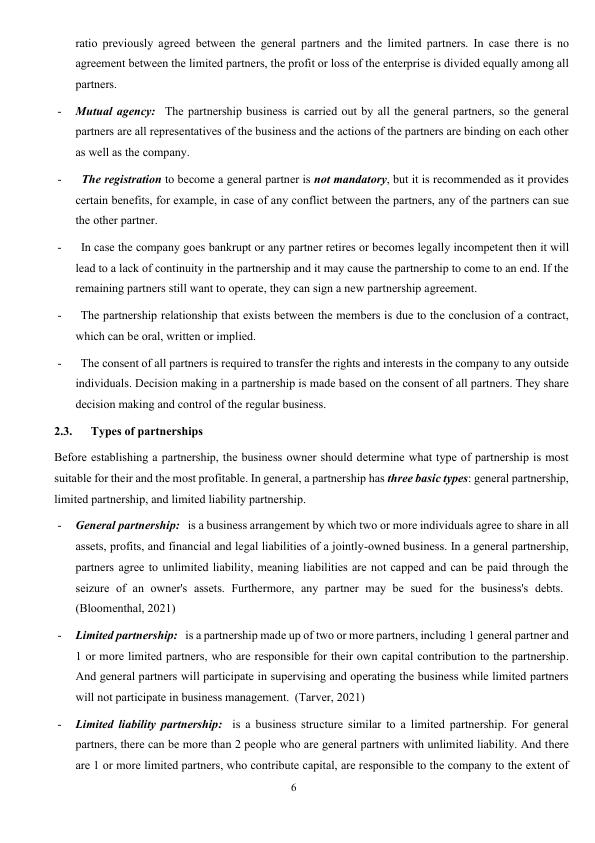
End of preview
Want to access all the pages? Upload your documents or become a member.
Related Documents
Types of Businesses and Business Activitieslg...
|21
|7917
|110
Characteristics, Advantages and Disadvantages of Sole Proprietorshiplg...
|5
|767
|20
Company Law: Characteristics, Functions, Regulatory Frameworks, and Policy Issueslg...
|12
|2775
|478
Form of Organisation and Legal Issueslg...
|6
|1355
|113
Introduction to Business Law: Case Study on Business Structureslg...
|12
|3026
|191
Business Law - case study solutionslg...
|8
|1371
|31
